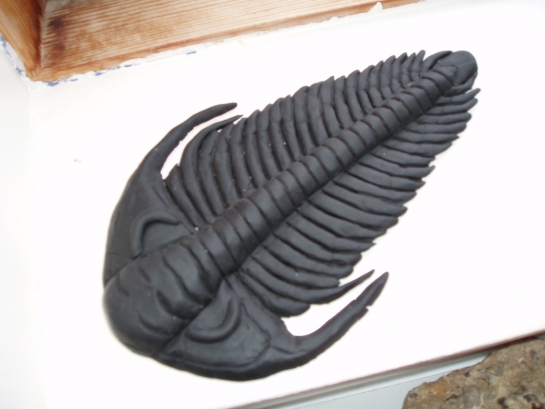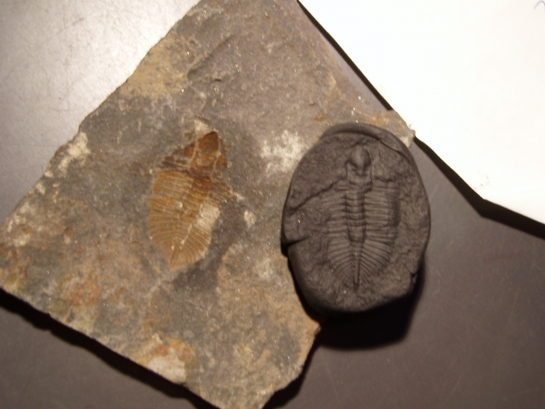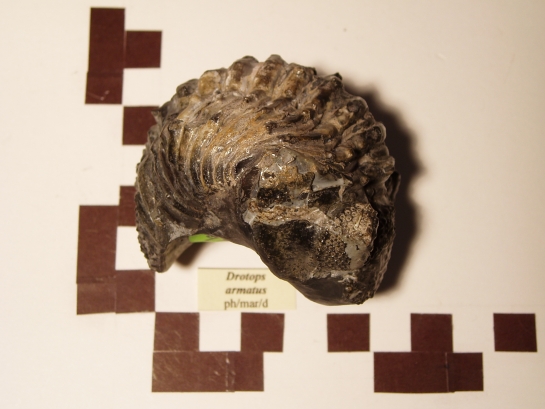Walking with dinosaurs
Antw: Walking with dinosaurs

....en dit is, los van de laatste vondsten, de meest recente creatie.
Mijn 17 cm, laten we maar zeggen Paradoxides.
Trilobiti Ceská Republika
Antw: Antw: Walking with dinosaurs
Nee, dacht het niet, is wel alweer een tijd geleden dat ik die video\'s gezien heb.ceraurus schreef:
staat daar iets over/met trilo\'s op?
Zo ja, laat ff weten als je wilt.
Het gaat over het tijdperk nadat de dinosauriërs uitgestorven zijn.
1) Triumph of the Beast
50 min Opkomst van het zoogdier.
2) The Beast Within
50 min Wetenschappelijke zoektocht naar de relatie tussen mens en aap.
Maar ik had ook liever het deel Swimming with Trilo\'s gehad
Wow! da\'s echt mooi zeg, iets voor aan de muur of aan de voordeur.ceraurus schreef:
....en dit is, los van de laatste vondsten, de meest recente creatie.
Mijn 17 cm, laten we maar zeggen Paradoxides.
Waarvan heb je dat gemaakt?
Wees nieuwsgierig - Stephen Hawking
Antw: Walking with dinosaurs
Op de DVD versie van \"Walking With Dinosaurs - Specials\" staat een kort stuk over trilo\'s op. (Sea Monsters) Daar wordt een nogal uit de kluiten gewassen trilo gebruikt om te \'vissen\'. klinkt nogal gek, maar \'t zit goed ineen. Als je interesse hebt kan ik wel *kuch* een kopietje maken *kuch*
Je moet me anders maar es mailen...

Z.
Je moet me anders maar es mailen...
Z.
The earth has music for those who listen.
- Frederik
- Administrator
- Berichten: 8668
- Lid geworden op: 28 sep 2003, 20:33
- Has thanked: 9 times
- Been thanked: 47 times
- Contacteer:
Antw: Antw: Walking with dinosaurs
O!ziepe schreef:
*kuch*
*wijst met vinger*
Try to learn something about everything and everything about
something (TH Huxley)
something (TH Huxley)
Antw: Walking with dinosaurs
That\'s the one!
Het vissen met de gigantische Isotelus zit in \'Sea monsters\' (WWD-specials).
Mijn kunststoffen Paradoxides is gemaakt van Fimo plastic afbakklei. Mijn vriendin heeft het goedje ooit eens hobbymatig gekocht in een brei-haak-en-schilderwinkel
Ik gebruik het materiaal ook om positieve trilobiet-afdrukken te maken van negatieve tegendrukken.
<:{{{{{>
Het vissen met de gigantische Isotelus zit in \'Sea monsters\' (WWD-specials).
Mijn kunststoffen Paradoxides is gemaakt van Fimo plastic afbakklei. Mijn vriendin heeft het goedje ooit eens hobbymatig gekocht in een brei-haak-en-schilderwinkel
Ik gebruik het materiaal ook om positieve trilobiet-afdrukken te maken van negatieve tegendrukken.
<:{{{{{>
Trilobiti Ceská Republika
Antw: Walking with dinosaurs
Je hebt natuurlijk ook nog altijd \"walking with monsters\", dat volgens mij in de lage landen nog niet op de markt is gebracht. \"Walking with monsters: Life before the dinosaurs\" gaat idd over het paleozoicum... voor 10£ te koop op de BBC website:
http://www.bbcshop.com/invt/bbcdvd1750& ... nature,119
Even googlen naar de inhoud:
The first episode begins with an illustration of the giant impact hypothesis: approximately 4.4 billion years ago when the Earth was formed, it is conjectured that a planet-like object referred to as Theia collided into the early Earth, dynamically reshaping the Earth and forming the moon. The episode then jumps ahead to the Cambrian Explosion, showing the first diversification of life in the sea and the emergence of a primitive fish known as Haikouichthys. Next, it shows the giant arthropods of the warm shallow continental seas of the Silurian, the emergence of the armoured \"jawless\" fish, and the colonization of the land by one of the first land plants. Finally, in the Devonian, it illustrates how lobe-finned fish eventually evolved into amphibians that could come on to land. It also discusses the evolutionary break-through of the amniote egg that allowed reptiles to permanently leave the water.
The second episode shows the swamp-like seas of the Carboniferous. It explains that because of a much higher oxygen content in the atmosphere, giant land arthropods evolved, including giant spiders (\"the size of a human head\"), millipedes (\"the size of a car\"), and dragonflies (\"the size of an eagle\"). It also depicts large predatory amphibians. The first half of the second episode follows the storyline of the giant spider Mesothelae as it tries to escape an intense lightning storm and rising waters. It shows the spider hunting down the small reptile Petrolacosaurus.
The episode then moves on to the early Permian, where the swamp-loving trees of Carboniferous have been replaced with more advanced conifers that are better adapted to survive in a changing climate. It depicts some of the earliest synapsids, or \"mammal-like reptiles\", known as pelycosaurs. It explains that the sailbacks of the pelycosaurs evolved as thermoregulatory devices. The second half of the second episode follows the storyline of a mother Dimetrodon, as it hunts down the herbivorous Edaphosaurus, and guards its nest from other Dimetrodons and from a scavenging Seymouria.
The third episode is set in the Late Permian, on the supercontinent Pangaea, which was covered by a vast and inhospitable desert. In this arid climate, early therapsids, which are described as more more \"mammal-like\" than reptile, are shown fighting to survive, including the fierce predator Gorgonops and the mole-like Diictodon. The episode discusses the simplified jaw of the Diictodon, that allowed some of its jaw bones to be used for primitive hearing (and that ultimately led to the evolution of the mammalian ear). It also shows the Scutosaurus, a distant relative of the turtle, whose body lacked a shell but which was heavily armoured with bony scutes on its skin and knobs and ridges on its skull.
The episode ends with a discussion of the Permian-Triassic extinction, the greatest extinction of life on earth, and how it led to the rise of the dinosaurs. Shortly after the mass extinction, herds of therapsids known as lystrosaurs soon dominated the terrain. The coinhabiting ancestor of the dinosaurs is shown to be the small archosaur Euparkeria, which was very swift but still in the process of evolving to be able to run on its hind legs. Of course, by the end of the Triassic, dinosaurs would radiate from these small archosaurs to dominate the land.
Lekker!!!
Ziepe
http://www.bbcshop.com/invt/bbcdvd1750& ... nature,119
Even googlen naar de inhoud:
The first episode begins with an illustration of the giant impact hypothesis: approximately 4.4 billion years ago when the Earth was formed, it is conjectured that a planet-like object referred to as Theia collided into the early Earth, dynamically reshaping the Earth and forming the moon. The episode then jumps ahead to the Cambrian Explosion, showing the first diversification of life in the sea and the emergence of a primitive fish known as Haikouichthys. Next, it shows the giant arthropods of the warm shallow continental seas of the Silurian, the emergence of the armoured \"jawless\" fish, and the colonization of the land by one of the first land plants. Finally, in the Devonian, it illustrates how lobe-finned fish eventually evolved into amphibians that could come on to land. It also discusses the evolutionary break-through of the amniote egg that allowed reptiles to permanently leave the water.
The second episode shows the swamp-like seas of the Carboniferous. It explains that because of a much higher oxygen content in the atmosphere, giant land arthropods evolved, including giant spiders (\"the size of a human head\"), millipedes (\"the size of a car\"), and dragonflies (\"the size of an eagle\"). It also depicts large predatory amphibians. The first half of the second episode follows the storyline of the giant spider Mesothelae as it tries to escape an intense lightning storm and rising waters. It shows the spider hunting down the small reptile Petrolacosaurus.
The episode then moves on to the early Permian, where the swamp-loving trees of Carboniferous have been replaced with more advanced conifers that are better adapted to survive in a changing climate. It depicts some of the earliest synapsids, or \"mammal-like reptiles\", known as pelycosaurs. It explains that the sailbacks of the pelycosaurs evolved as thermoregulatory devices. The second half of the second episode follows the storyline of a mother Dimetrodon, as it hunts down the herbivorous Edaphosaurus, and guards its nest from other Dimetrodons and from a scavenging Seymouria.
The third episode is set in the Late Permian, on the supercontinent Pangaea, which was covered by a vast and inhospitable desert. In this arid climate, early therapsids, which are described as more more \"mammal-like\" than reptile, are shown fighting to survive, including the fierce predator Gorgonops and the mole-like Diictodon. The episode discusses the simplified jaw of the Diictodon, that allowed some of its jaw bones to be used for primitive hearing (and that ultimately led to the evolution of the mammalian ear). It also shows the Scutosaurus, a distant relative of the turtle, whose body lacked a shell but which was heavily armoured with bony scutes on its skin and knobs and ridges on its skull.
The episode ends with a discussion of the Permian-Triassic extinction, the greatest extinction of life on earth, and how it led to the rise of the dinosaurs. Shortly after the mass extinction, herds of therapsids known as lystrosaurs soon dominated the terrain. The coinhabiting ancestor of the dinosaurs is shown to be the small archosaur Euparkeria, which was very swift but still in the process of evolving to be able to run on its hind legs. Of course, by the end of the Triassic, dinosaurs would radiate from these small archosaurs to dominate the land.
Lekker!!!
Ziepe
The earth has music for those who listen.
Antw: Walking with dinosaurs
Lijkt mij een aanrader, die ga ik kopen, bedankt voor de tip.ziepe schreef
Walking with monsters: Life before the dinosaurs\" gaat idd over het paleozoicum... voor 10£ te koop op de BBC website
Dan kan het echt leuk worden, bijna gevaarlijk leuk.ceraurus schreef:
Ik gebruik het materiaal ook om positieve trilobiet-afdrukken te maken van negatieve tegendrukken.
Ik heb die jongen op de foto al een hele tijd, volgens de overlevering een ongeverfde gipsafdruk van Phacops Giganteum, Devoon - Erfound - Marocco.
Denk je dat dat kan kloppen?
Met enige fantasie laat het mooi zien hoe erg je bedonderd kan worden met een nepfossiel.
Wees nieuwsgierig - Stephen Hawking
Antw: Walking with dinosaurs
Drotops megalomanicus, mooie afdruk!
Er doen vele namen over deze soort de ronde maar dit is de \'officiele\' naam. \'giganteum\' had ik overigens nog niet gehoord.

Ik heb ze al eerder zo wit gezien; maar dan ook echt met een witte \'patina\' laag erop.
Maar gips, dat voel je toch in het gewicht Alfer?
Ik heb een opgerold broertje van die soort Drotops armatus ssp.
Google maar eens op de allereerste naam dan vind je hem wel.
<:{{{{{>
[Bewerkt door Ceraurus op 22-06-2006 om 22:05 NL]
Er doen vele namen over deze soort de ronde maar dit is de \'officiele\' naam. \'giganteum\' had ik overigens nog niet gehoord.
Ik heb ze al eerder zo wit gezien; maar dan ook echt met een witte \'patina\' laag erop.
Maar gips, dat voel je toch in het gewicht Alfer?
Ik heb een opgerold broertje van die soort Drotops armatus ssp.
Google maar eens op de allereerste naam dan vind je hem wel.
<:{{{{{>
[Bewerkt door Ceraurus op 22-06-2006 om 22:05 NL]
Trilobiti Ceská Republika
Antw: Walking with dinosaurs

...en zo komt (ff snel op de foto) zo\'n tegendruk eruit te zien, afgebakken en wel met alle details (gaat nooit meer kapot)
<:{{{{{>
Trilobiti Ceská Republika
